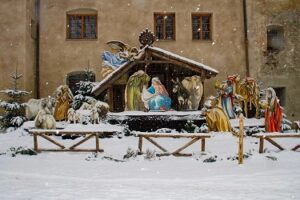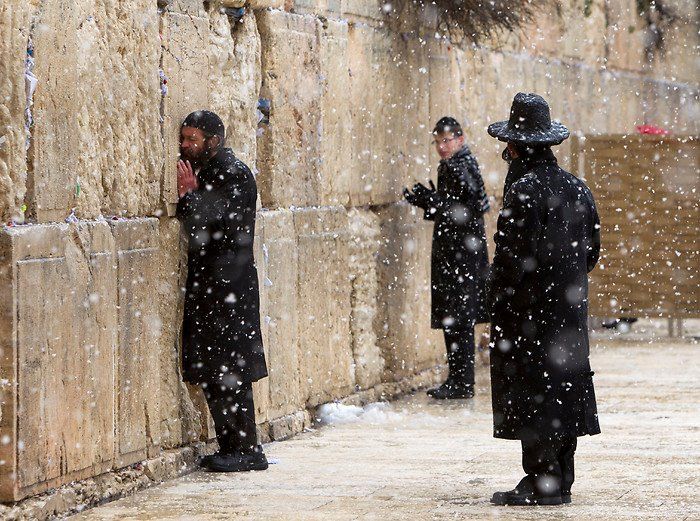 When you see the title of the English Christmas carol “See Amid the Winter’s Snow,” you have to ask yourself the question in the title of this post.
When you see the title of the English Christmas carol “See Amid the Winter’s Snow,” you have to ask yourself the question in the title of this post.
And the answer is: Probably not. Snow in Israel is very rare. I’m posting a picture below of a historic snowfall in Jerusalem in 2013. Normally, though, there are two seasons in this part of the world: the wet and the dry. If Jesus were indeed born in December, the weather could have been cold and wet but probably not snowy.
So why all the snow in those Nativity scenes? Well, there are two answers, one simple and one more complicated. Let’s take the simple one first: The season typically associated with Christmas can be cold and snowy in the western/northern hemisphere, and so songs and images produced in that area of the world follow that season.
The more complicated answer: snow has all sorts of symbolism connected with it, the most common one that of purity. Think about it: how clean and white the world looks after a snowfall! Also, the snow holds the promise of life beneath it. That thick blanket of snow looks sterile and cold, and it is, but that doesn’t mean that it’s deadly. There’s plenty of potential there, and when spring comes the shoots from perennials and the leaves on those formerly-bare branches show its fulfillment. So the Christ Child is seen as part of that miraculous-seeming life, blooming even in the midst of winter. I wrote about the image of the “Christmas Rose” several season ago; you might want to take a look there if you’re interested.
Edward Caswell, the author of the lyrics, might be a bit miffed at how his seven-stanza poem is usually treated today, since, as in our arrangement, it is mercilessly pruned. (Sort of like those perennials mentioned in the paragraph above.) His life almost exactly overlaps that of Charles Dickens, and he started out his career as an Anglican minister, serving near Salisbury, England, for a number of years. Here’s a tidbit about his time there: “As curate, he would invite the children who had attended morning services to the parsonage and give them breakfast. On the anniversary on one’s baptism, he would give some money to buy clothes.” (Wikipedia) Isn’t that interesting? He seems to have had a real soft spot for children, and his descriptions of the Christ Child echo that attitude, as he uses the word “tender” twice in the verses normally sung.
Even in those three short verses, though, Caswell packed a lot of theology. Ever mindful of my word limits, I will pick out just a few ideas. First, the Christ Child is called “the tender Lamb,” which isn’t a description included in the actual account of the Nativity in the New Testament Gospels. Caswell is using imagery from later on in the life of Jesus, probably referencing John the Baptist’s words upon seeing Jesus: “Behold the Lamb of God, that taketh away the sin of the world.” (John 1:29 KJV) I also find the next line to be meaningful: “Promised from eternal years.” Caswell is saying that this birth was prophesied even before the world began, with a probable reference from the Book of Revelation: “the Lamb slain from the foundation of the world.” (13:8 KJV) And you may have found Caswell’s verb tenses a little confusing in these lines:
Lo, within a manger lies
He who built the lofty skies,
He, who, throned in light sublime,
Sits amid the cherubim.
How can the baby in the manger also be sitting in the midst of the cherubim (whatever they are)? Let me unpack these brief lines a little. The birth of Christ involves the idea of the “Incarnation,” a doctrinal term that means “the union of divinity with humanity in Jesus Christ” (straight from Merriam-Webster). Do you see the “carn” part of the word, by the way? It has exactly the same meaning there as in “carnitas” or “chili con carne”—“flesh.” (I have a hard time resisting the siren call of Latin derivations.) So, to go back to the Gospel of John again, “the Word was made flesh, and dwelt among us.” (1:14 KJV) Christian theology identifies Christ with the creation and as someone who is now seated at the right hand of God the Father. Caswell presents both realities in the present tense.
You may be wondering about the other four verses of Caswell’s poem. (Then again, you may not.) Two are about the shepherds, one is a prayer to the Christ Child, and one is a prayer to the Virgin Mary. By the time Caswell wrote these lyrics he had converted to Roman Catholicism. But that’s a whole ‘nother story, one which I have no time to tell.
And why don’t I? Because I want to include at least a little information about Dan Forrest, who wrote the arrangement that my own choir has sung. We’ve sung several of his pieces in the past few years, and it’s safe to say that we’ve loved doing so. He’s become quite prominent in the choral world and was honored in November 2019 as the first American composer ever featured in the Koorproject Opus in the Netherlands. Unfortunately, I didn’t copy and paste the info from Forrest’s website before the event, and now the link is just to the Dutch site, which is written, for some strange reason, in Dutch. It all seems to be a pretty big deal, though. Forrest’s Requiem for the Living—and isn’t that an interesting title?—and Jubilate Deo were performed in three cities, including Amsterdam in the Royal Concertgebauw (“concert building”).
I feel a bit of proprietary pride in Forrest’s work because he holds a bachelor’s and master’s degree from the same university I attended. We didn’t overlap or anything since he’s (ahem) about a quarter of a century younger than I, but hey! I had a lot of fun reading his Wikipedia entry and seeing the names of a couple of faculty members who were there when I attended and who also taught him. I hope we sing many, many more of his arrangements and compositions.
And with that I must, must close. Here’s the promised picture of Israel in the snow from 2013, one taken at the Wailing Wall in Jerusalem:

I must also include a lovely, lovely performance of Forrest’s arrangement with all sorts of evocative stuff:
© Debi Simons

